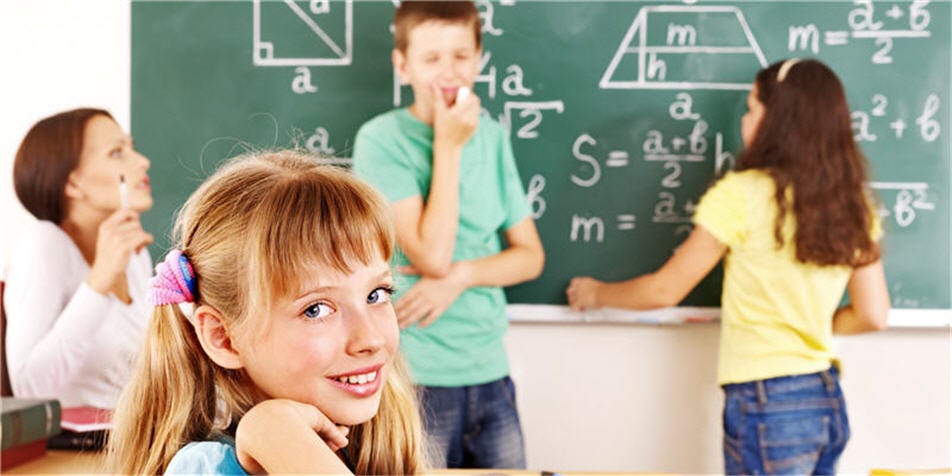
A professional learning community is more than simply a collection of teachers working in the same building. A learning community comes together around people from every part of the school working collaboratively at all levels. That collaborative work is founded in what we call reflective dialogue, meaning staff conversations about issues and problems related to students, learning, and teaching.
Professional learning communities are characterized by:
- a principal who shares leadership, power, and authority and participates collegially by encouraging staff involvement in decision making;
- a shared vision developed from staff's unswerving commitment to students' learning and consistently articulated and referenced for the staff's work;
- opportunities for teacher-to-teacher visitation and observation accompanied by feedback and assistance as needed;
- sharing of personal practice;
- sharing of success stories and celebration of achievements.
What Are the Benefits of a Professional Learning Community for Teachers?
Teachers who view their schools as professional learning communities report fewer feelings of isolation, are more likely to see themselves as "professionally renewed," and view their work as more satisfying. In addition:
- teachers are more committed to the goals and mission of the school, and they work with more vigor to strengthen the mission.
- sharing good teaching practices helps create greater knowledge and beliefs about teaching and learners.
From the perspective of staff morale, teachers report feeling energized when they have increased opportunities for professional conversations with other teachers. The existence of a professional learning community encourages risk taking and innovation by teachers, one reason improvement efforts seem to be more productive in schools of this type.
What Are the Benefits for Students?
The characteristics of a professional learning community translate into concrete benefits for students, including academic gains in mathematics, science, history, and reading. These gains tend to be greater in schools structured as professional learning communities than they are in traditional schools, and the schools tend to demonstrate smaller achievement gaps between students from different backgrounds. These schools also are reported to have lower dropout rates, fewer missed classes, and lower rates of absenteeism.
How Can Principals Create Professional Learning Communities?
Leadership is essential for professional learning communities to be effective. Principals need to provide opportunities for teachers to meet and share effective practices, develop interdependent teaching roles, and grow personally and professionally. Often, this means dramatically restructuring school schedules and providing opportunities within the school day for teachers to work, plan, and learn together around instructional issues. A new study found effective schools routinely provided time for collaboration, and principals supported risk-taking and experimentation by the teachers. As collaboration developed, so did collegiality.
Principals must also take the lead in initiating teacher-to-teacher conversations that are significantly different than those many teachers currently experience. All people in the organization must have a clear sense of the mission they are to accomplish, and they must work together as a team toward their goals. They must identify weaknesses, but also support each other as they implement new strategies to address areas of concern. And they must work together to bridge the gaps caused by grade and subject matter specialization.
How Can Professional Learning Communities Be Sustained?
School leaders should not wait until a learning community is established before thinking about how to sustain it. A question that should be asked from the very beginning is: What elements must be firmly in place to motivate and encourage teachers to continually engage in learning activities? Some ideas are:
- Celebrations. Honor positive actions and progress made toward community goals.
- Training. Provide teachers with instruction in group process skills, conflict management, and content-specific areas such as literacy instruction.
- Ongoing data collection and analysis. Develop procedures for regular monitoring of student performance data; collect data throughout the year, not just at its end. Provide opportunities for teachers to collaborate around data analysis.
- Teacher study groups and peer coaching. Provide structure for regular teacher interaction.
What Impact Does School Environment Have on Student Achievement?
Research shows that student achievement is supported by schools that provide a safe and caring environment. For many students, particularly those at risk of school failure, the caring relationship often must precede their engagement with subject matter. When schools create an atmosphere in which there are lines of open communication and interpersonal connection between students and school staff, students are more willing to share concerns with school staff. But if students don't feel a bond with their school community, it can affect their feelings of safety at school, their emotional growth, social development, and their motivation to learn.
What Is the Connection Between Caring and High Achievement?
Students also felt that it was important to them that their teachers pushed them to succeed. The literature repeatedly mentions the value of making sure that every student feels known and valued by at least one adult in the school.
What are Some Strategies that Can be Used to Build Connections?
Bonding and having a strong connection with others in the school community plays a major role in creating safe schools. One strategy is for teachers to find ways to form long-term student-teacher relationships. Another strategy would be for schools to link caring teachers, other school staff, and/or community volunteers with students needing support through mentoring programs. As an alternative to a formal one-on-one mentoring program, schools can create mentor-rich environments in which students have the opportunity to form relationships with teachers, coaches, supervisors, youth workers, counselors, social workers, and other adults who have the time and inclination to establish close ties with young people. Connections can also be built through morning meetings. For example, we can incorporate the following during each meeting:
- Greetings. The class uses a variety of greeting activities throughout the school year, such as saying hello in different languages.
- Sharing. The student sharing information makes a brief statement to introduce his/her news, then ends by asking if there are any questions or comments.
- Group Activity. This fast-paced activity involves all members, and it may be directly linked to relevant academic skills, focused on general skills, such as observing or remembering, or designed simply for fun.
- News and Announcements. The group focuses on an announcement that the teacher posted on the board earlier, which includes a welcome message, the activity the class will be doing for the day, and a question or challenge. The group reads the announcement together, discusses the content, and does some related, short activities. This segment provides a transition into the rest of the school day.
What Is the Importance of Class Size and School Size?
Students in smaller schools and classes tend to have more of a sense of belonging and attachment. Smaller class size offers more opportunities for each student to excel, and can be extremely beneficial to at-risk students. In addition, class and school size have a significant impact on education leaders. efforts to personalize the school environment.
Many schools have found ways to create small school units; however some plans for smaller school units may not yield the benefits of small schools unless they have autonomous leadership, fiscal independence, and a feeling of separate identity. Larger schools can successfully be turned into separate, smaller schools, creating a more supportive learning environment.
Class size reduction (CSR) has been a complex and often contentious issue for the last quarter century. While there is an intuitive sense that reducing class size can have a positive effect on student achievement, it is an expensive approach. Thus, educators have looked to research to provide them with solid answers on two key and very basic questions: Does class size reduction really make a difference? What do experiences with class size reduction tell us about both the benefits and the costs?
What are the Potential Benefits to Class Size Reduction?
Research and lessons from practice indicate that CSR has potential benefits, including achievement gains, for some students, especially poor and minority students or students in the early grades. Other potential benefits include the possibilities for increased individualized attention for students by teachers improved identification of special needs, allowing for earlier intervention and less remediation.
Expanded flexibility by teachers to use different instructional approaches and assignments is also a potential benefit, as is more in-depth coverage of content. Some teachers practicing in smaller have reported fewer distractions for students, more time for students to speak while the others listen, reduced level of noise in a class and reduced discipline problems. Research suggests that CSR allows teachers to better track how each student is doing and makes it easier for students to develop positive relations with classmates and the teacher. While federal dollars are no longer allocated specifically for class size reduction, several states have recently created or expanded CSR programs.
What are Some Alternatives to CSR?
Among the alternatives to wholesale class size reduction targeting class size reduction to schools and students most in need, e.g., high-minority and high-poverty schools, redeploying school staff for part or all of the school day so that class sizes are especially small for classes such as early reading instruction, and eliminating the use of teacher aides and putting dollars into hiring more teachers. Another alternative would be providing teachers professional development aligned with district initiatives in order to further develop teacher knowledge, skill, and effectiveness.
What Role Does a Student's Relationship with His or Her Peers Play?
Strong bonds with students are a necessary component in developing a caring school. Teachers should make sure that no student is left to feel isolated from fellow students. However, educators should not set out to dissolve any in crowds, because peer groups can lead to ways in which students learn to establish an autonomous sense of identity. Rather, school personnel should look out for instances in which some students are isolated from every existing peer group. Educators should also watch for any signs of tension between different peer groups, or if there is a group that may seem threatening to adults or other students within the school.
Jeff C. Palmer is a teacher, success coach, trainer, Certified Master of Web Copywriting and founder of https://Ebookschoice.com. Jeff is a prolific writer, Senior Research Associate and Infopreneur having written many eBooks, articles and special reports.
Source: https://ebookschoice.com/what-impact-does-school-environment-have-on-student-achievement/

